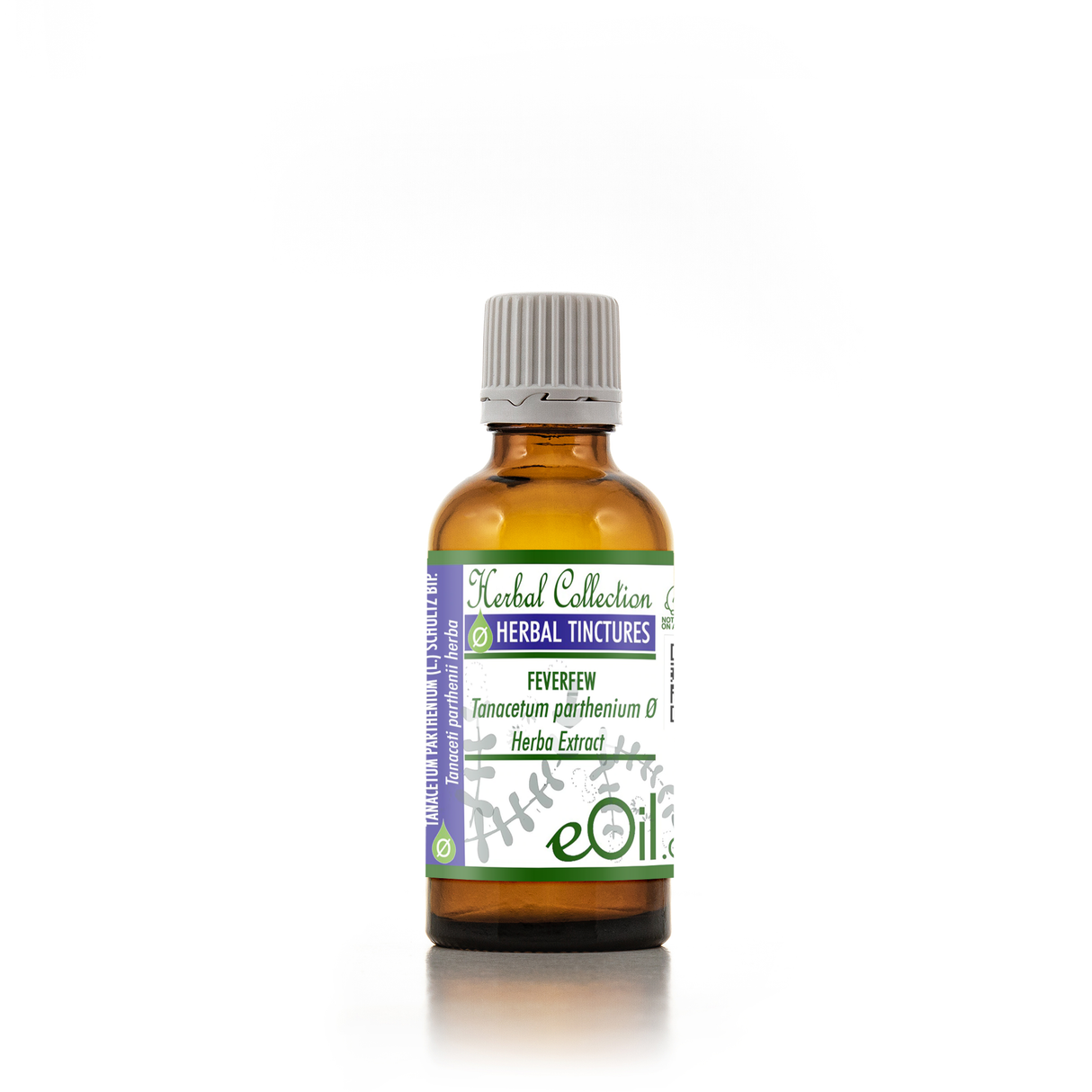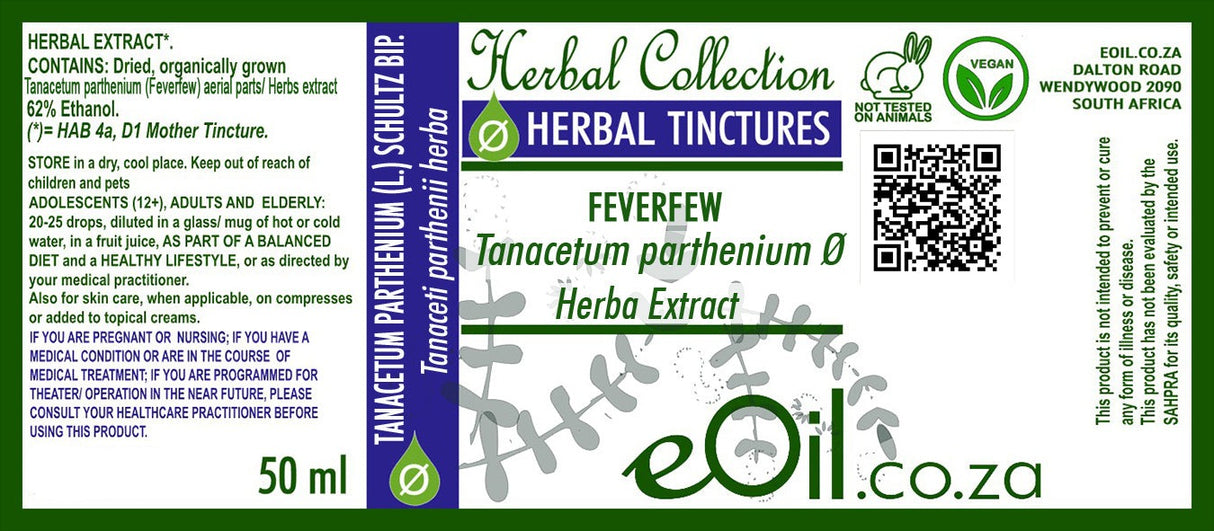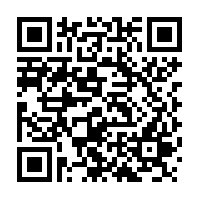Feverfew - Liquid Herbal Extract
Feverfew - Liquid Herbal Extract - 50 ML is backordered and will ship as soon as it is back in stock.
Description
Description
Understanding Mother Tinctures & Glycerines
Feverfew liquid herbal extract is crafted from the aerial parts of Tanacetum parthenium, a plant valued for its traditional role in supporting wellness and the body's natural response to headaches.
This plant-based tincture is suitable for daily use and free from artificial additives, ideal for those seeking holistic wellness support
TRADITIONALLY USED FOR
May help with
- anti-amoebic
- Fevers
- Migraine - Headache
- antibacterial
- Liver protection (hepatic protector)
- Oxyacanthine (stimulation salivary secretion)
- cytostatic
INFORMATION
Source : http://www.wikiphyto.org/wiki/Feverfew
Reference on http://www.wikiphyto.org
Translation in English by Google Translate (go to the page of the source linked | on Chrome cellphones go on the 3 dots on the top right and select translate in your preferred language | on laptop right click your mouse and select option translate when hoovering on the page
plant name
Feverfew , parternal , feverfew (English)
International Latin denomination
Tanacetum parthenium (L.) Schultz-Bip., Chrysanthemum parthenium (L.) Pers., Pyrethrum parthenium Sm.
botanical family
Asteraceae (Compositae)
Description and habitat
- Perennial herb native to Asia Minor, common in waste places in Europe
- Stems branched, leaves pennate in oblong segments subdivided into entire or crenate lobes
- Heads of yellow tubular flowers and white ligulate grouped in corymbs
History and tradition
- Use in fairly recent herbal medicine
- Parthenolide is present in drugs of European origin, absent in American drugs
Parts used
- Aerial parts, ( essential oil )
Dosage forms available
- Teinture-mère of Pyrethrum parthenium (= Chrysanthemum parthenium )
- EPS
- Dry extract (elusane®)
Usual dosages
- 2.5 to 5 grams of infusion
Composition
Main components of the plant
- Lactones sesquiterpéniques :
- Parthenolide , epoxy-artemorin , canine , artecanine , seco-tana-parthanolides A and B, tanaparthine-alpha-peroxide , reynosine , santamarin , santine
- Camphor essential oil
- Flavonoids
Main components of buds or young shoots
Main components of essential oil
Properties
Plant properties
- Analgesic [1] , [2] , [3] , and anti-inflammatory like other plants of the genus Tanacetum [4]
- Anti-migraine [5] , [6] , [7] , inhibits platelet aggregation and serotonin release induced by ADP or adrenaline, which would explain the activity [8] , [9] , action parthenolide on the trigeminal vasculature [10]
- The improvement seems potentiated by taking white willow (300 mg of each) [11]
- Literature reviews are positive but recommend further clinical studies [12] , [13]
- Blockade of lipopolysaccharide-mediated TNF-α release, suppression of CCL2 (monocyte chemoattractant protein l or MCP-I), a likely cellular target for feverfew's antimigraine effects [14]
- Parthenolide inhibits nitroglycerin -induced neuronal activation [15]
- Inhibits the biosynthesis of prostaglandins, which may explain an action in dysmenorrhea [16] , [17]
- Anti-inflammatory by flavonoids [18] , (a flavonol , 6-hydroxykaempferol 3,7,4'-trimethyl ether or tanetin ) [19] , and by parthenolide [20] , itself anti-cancer and pro-apoptotic
- Inhibition of granulocyte degranulation and the release of enzymes involved in inflammatory phenomena
- Protective effect on vascular endothelial cells
- Antispasmodic of smooth muscles by alpha-blocker effect, inhibits contractions induced by serotonin and phenylephrine (α1-adrenergic agonist) by sesquiterpene lactones ( reynosine , santamarin , santine ) [21]
- An extract of Tanacetum parthenium leaves inhibits aortic smooth muscle phospholipase A2 [22]
- Parthenolide induces apoptosis [23]
- Parthenolide and some of its hemi-synthetic derivatives show anti-leukemic activity on chronic lymphoid leukemias [24] , [25] , [26] , [27]
Bud properties
Properties of essential oil
Indications
Indications of the whole plant (phytotherapy)
- Prevention of migraine attacks [28] , [29] , [30] , recent literature reviews show additional evidence, with no major safety issues [31]
- Menstruation pain, dysmenorrhea, catamenial migraines, labor pain [32]
- Parthenolide inhibits the development of endometriosis by suppressing the inflammatory peritoneal environment through the nuclear factor κB pathway in a mouse model [33] , but it may worsen it depending on dosage [34]
- The effectiveness of feverfew on migraines seems to have been known since antiquity, but it was not until the 1980s that Murphy's work confirmed it with a double-blind study: significant improvement in symptoms and frequency of recurrences migraine in the 72 volunteers in this study, with no serious side effects [35]
- Feverfew would act by inhibiting the secretion of serotonin by platelets (Heptinstalls) [36] , [37]
- The dose of 0.20% of parthenolide seems to be the minimum threshold of effectiveness in preparations based on dried leaves.
- In 1997, Murch and his team evaluated melatonin levels in the green leaves of feverfew, and found them to be elevated, confirming previous work on the beneficial role of rebalancing melatonin levels in migraine sufferers without aura [38].
Indications of the bud (gemmotherapy)
Specific indications of essential oil (aromatherapy)
Known or suspected mode of action
- Inhibits platelet aggregation and serotonin release induced by ADP or adrenaline
- Interaction of methylene lactone with thiol groups
Usual formulations
Regulations
- French Pharmacopoeia list A (aerial part)
Possible side effects and precautions for use
- Not recommended with anticoagulants and antiplatelet agents (risk of potentiation)
- Potential interactions with warfarin [39]
- No interaction with P-glycoprotein
- Moderate inhibition of CYP2C8, CYP1A2, CYP2D6, CYP2C9, CYP3A4 activity [40] , [41]
- All sesquiterpene lactones can be responsible for allergic dermatitis, suspected cytotoxicity
- Prohibited in pregnant women [42] , [43] : Tanacetum parthenium is emmenagogue (causes menstruation) and can be abortifacient [44]
Bibliographic references
- Go↑ Jain NK, Kulkarni SK. Antinociceptive and anti-inflammatory effects of Tanacetum parthenium L. extract in mice and rats. J Ethnopharmacol. 1999 Dec 15;68(1-3):251-9. PMID 10624885
- Go↑ Parvin, Neda & Asgari, A.. (2012). The Analgesic Effect of Alcoholic Extract of Tanacetum Parthenium on Pain in Mice in Formalin Model. 14. 63-69.
- Go↑ Fereydouni M, Etemadi L, Borouk A. Analgesic effect of flower and leaf extracts of Tanacetum parthenium using formalin test in mice. Physiology and pharmacology, 2001-Winter 2002 , Volume 5 , Number 2; Page(s) 189-198.
- Go↑ Ishfaq Ali Bukhari, Rafeeq Alam Khan, Anwar-ul Hassan Gilani, Abdul Jabbar Shah, Javid Hussain, Viqar Uddin Ahmad. The analgesic, anti-inflammatory and calcium antagonist potential of Tanacetum artemisioides. Archives of Pharmacal Research, Volume 30, Number 3 (2007), 303-312
- Go↑ D. Palevitch, G. Earon, R. Carasso. Feverfew (Tanacetum parthenium)as a prophylactic treatment for migraine: a double-blind placebo-controlled study. Phytotherapy Research, Volume 11, Issue 7, pages 508–511, November 1997 texte intégral
- Go↑ Pfaffenrath V, Diener HC, Fischer M, Friede M, Henneicke-von Zepelin HH, and Investigators. The efficacy and safety of Tanacetum parthenium (feverfew) in migraine prophylaxis--a double-blind, multicentre, randomized placebo-controlled dose-response study. Cephalalgia. 2002 Sep;22(7):523-32. PMID 12230594
- Go↑ Diener HC, Pfaffenrath V, Schnitker J, Friede M, Henneicke-von Zepelin HH. Efficacy and safety of 6.25 mg t.i.d. feverfew CO2-extract (MIG-99) in migraine prevention--a randomized, double-blind, multicentre, placebo-controlled study. Cephalalgia. 2005 Nov;25(11):1031-41. PMID 16232154
- Go↑ WHO monographs on selected medicinal plants VOLUME 2 (Monographies de l’OMS). World Health Organization. 2002
- Go↑ Johnson ES, Kadam NP, Hylands DM, Hylands PJ. Efficacy of feverfew as prophylactic treatment of migraine. Br Med J (Clin Res Ed). 1985 Aug 31;291(6495):569-73. PMID 3929876, texte intégral [1]
- Go↑ Materazzi S, Benemei S, Fusi C, Gualdani R, De Siena G, Vastani N, Andersson DA, Trevisan G, Moncelli MR, Wei X, Dussor G, Pollastro F, Patacchini R, Appendino G, Geppetti P, Nassini R. Parthenolide inhibits nociception and neurogenic vasodilatation in the trigeminovascular system by targeting the TRPA1 channel. Pain. 2013 Dec;154(12):2750-8. doi: 10.1016/j.pain.2013.08.002. PMID 23933184 texte intégral
- Go↑ Shrivastava R, Pechadre JC, John GW. Tanacetum parthenium and Salix alba (Mig-RL) combination in migraine prophylaxis: a prospective, open-label study. Clin Drug Investig. 2006;26(5):287-96. PMID 17163262
- Go↑ Vogler BK, Pittler MH, Ernst E. Feverfew as a preventive treatment for migraine: a systematic review. Cephalalgia. 1998 Dec;18(10):704-8. PMID 9950629
- Go↑ Pittler MH, Ernst E. Feverfew for preventing migraine. Cochrane Database Syst Rev. 2004;(1):CD002286. PMID 14973986
- Go↑ Chen CF, Leung AY. Gene response of human monocytic cells for the detection of antimigraine activity of feverfew extracts. Can J Physiol Pharmacol 2007, 85:1108-1115. PMID 18066113
- Go↑ Tassorelli C, Greco R, Morazzoni P, Riva A, Sandrini G, Nappi G. Parthenolide is the component of tanacetum parthenium that inhibits nitroglycerin-induced Fos activation: studies in an animal model of migraine. Cephalalgia. 2005 Aug;25(8):612-21. PMID 16033387
- Go↑ Pugh, W. J., & Sambo, K. (1988). Prostaglandin synthetase inhibitors in feverfew. Journal of pharmacy and pharmacology, 40(10), 743-745. https://doi.org/10.1111/j.2042-7158.1988.tb07010.x. PMID 2907548
- Go↑ Collier HO, Butt NM, McDonald-Gibson WJ, Saeed SA. Extract of feverfew inhibits prostaglandin biosynthesis. Lancet. 1980 Oct 25;2(8200):922-3. doi: 10.1016/s0140-6736(80)92084-x. PMID 6107575
- Go↑ Williams CA, Harborne JB, Geiger H, Hoult JR. The flavonoids of Tanacetum parthenium and T. vulgare and their anti-inflammatory properties. Phytochemistry. 1999 Jun;51(3):417-23. PMID 10382317
- Go↑ Williams CA, Hoult JR, Harborne JB, Greenham J, Eagles J. A biologically active lipophilic flavonol from Tanacetum parthenium. Phytochemistry. 1995 Jan;38(1):267-70. PMID 7766058
- Go↑ Hwang D, Fischer NH, Jang BC, Tak H, Kim JK, Lee W. Inhibition of the expression of inducible cyclooxygenase and proinflammatory cytokines by sesquiterpene lactones in macrophages correlates with the inhibition of MAP kinases. Biochem Biophys Res Commun. 1996 Sep 24;226(3):810-8. PMID 8831694
- Go↑ Alejandra Orona-Ortiz, Leticia García-de la Cruz, Israel González-Soto, Liana Medina-Cruz, José Luis Balderas López, José Carlos Tavares Carvalho, Andrés Navarrete. Inhibition of phenylephrine- or serotonin-induced rat aorta contractions by Mexican feverfew (Tanacetum parthenium (L.) Schultz-Bip). Latin American Chemistry, Vol 46 No 2-3 (2018)
- Go↑ Thakkar JK, Sperelakis N, Pang D, Franson RC. Characterization of phospholipase A2 activity in rat aorta smooth muscle cells. Biochim Biophys Acta. 1983 Jan 7;750(1):134-40. PMID 6824708
- Go↑ Pajak B, Gajkowska B, Orzechowski A. Molecular basis of parthenolide-dependent proapoptotic activity in cancer cells. Folia Histochem Cytobiol. 2008;46(2):129-35. doi: 10.2478/v10042-008-0019-2. PMID 18519227
- Go↑ Steele, A. J., Jones, D. T., Ganeshaguru, K., Duke, V. M., Yogashangary, B. C., North, J. M., Lowdell, M. W., Kottaridis, P. D., Mehta, A. B., Prentice, A. G., Hoffbrand, A. V., & Wickremasinghe, R. G. (2006). The sesquiterpene lactone parthenolide induces selective apoptosis of B-chronic lymphocytic leukemia cells in vitro. Leukemia, 20(6), 1073–1079. https://doi.org/10.1038/sj.leu.2404230 PMID 16628188
- Go↑ Guzman ML, Rossi RM, Karnischky L, Li X, Peterson DR, Howard DS, Jordan CT. The sesquiterpene lactone parthenolide induces apoptosis of human acute myelogenous leukemia stem and progenitor cells. Blood. 2005 Jun 1;105(11):4163-9. doi: 10.1182/blood-2004-10-4135. PMID 15687234
- Go↑ Quy, A. S., Li, X., Male, L., Stankovic, T., Agathanggelou, A., & Fossey, J. S. (2020). Aniline-containing derivatives of parthenolide: Synthesis and anti-chronic lymphocytic leukaemia activity. Tetrahedron, 76(48), 131631. https://doi.org/10.1016/j.tet.2020.131631 PMID 33299257
- Go↑ Li X, Payne DT, Ampolu B, Bland N, Brown JT, Dutton MJ, Fitton CA, Gulliver A, Hale L, Hamza D, Jones G, Lane R, Leach AG, Male L, Merisor EG, Morton MJ, Quy AS, Roberts R, Scarll R, Schulz-Utermoehl T, Stankovic T, Stevenson B, Fossey JS, Agathanggelou A. Derivatisation of parthenolide to address chemoresistant chronic lymphocytic leukaemia. Medchemcomm. 2019 Aug 1;10(8):1379-1390. doi: 10.1039/c9md00297a. eCollection 2019 Aug 1. PMID 32952998
- Go↑ Ernst E, Pittler MH. The efficacy and safety of feverfew (Tanacetum parthenium L.): an update of a systematic review. Public Health Nutr. 2000 Dec;3(4A):509-14. PMID 11276299
- Go↑ Holland S, Silberstein SD, Freitag F, Dodick DW, Argoff C, Ashman E. Evidence-based guideline update: NSAIDs and other complementary treatments for episodic migraine prevention in adults: report of the Quality Standards Subcommittee of the American Academy of Neurology and the American Headache Society. Neurology. 2012 Apr 24;78(17):1346-53. doi: 10.1212/WNL.0b013e3182535d0c. PMID 22529203
- Go↑ Rajapakse T, Davenport WJ. Phytomedicines in the Treatment of Migraine. CNS Drugs. 2019 May;33(5):399-415. doi: 10.1007/s40263-018-0597-2. PMID 30627973.
- Go↑ Wider B, Pittler MH, Ernst E. Feverfew for preventing migraine. Cochrane Database of Systematic Reviews 2015, Issue 4. Art. No.: CD002286. DOI: 10.1002/14651858.CD002286.pub3
- Go↑ Pareek A, Suthar M, Rathore GS, Bansal V. Feverfew (Tanacetum parthenium L.): A systematic review. Pharmacogn Rev. 2011 Jan;5(9):103-10. doi: 10.4103/0973-7847.79105. PMID 22096324 texte intégral
- Go↑ Takai E, Taniguchi F, Nakamura K, Uegaki T, Iwabe T, Harada T. Parthenolide reduces cell proliferation and prostaglandin E2 [corrected] in human endometriotic stromal cells and inhibits development of endometriosis in the murine model. Fertil Steril. 2013 Oct;100(4):1170-8. doi: 10.1016/j.fertnstert.2013.06.028. PMID 23876538
- Go↑ Song H, Huang Y, Peng Q, Xue C, Zhou YF. Effects of parthenolide on estradiol-synthesizing enzyme, ER isoforms and VEGF in human endometriotic stromal cells. Zhonghua Fu Chan Ke Za Zhi. 2019 Jul 25;54(7):464-469. doi: 10.3760/cma.j.issn.0529-567x.2019.07.006. PMID 31365959
- Go↑ Murphy JJ, Heptinstall S, Mitchell JR. Randomised double-blind placebo-controlled trial of feverfew in migraine prevention. Lancet. 1988 Jul 23;2(8604):189-92. PMID 2899663
- Go↑ Heptinstall S, White A, Williamson L, Mitchell JR. Extracts of feverfew inhibit granule secretion in blood platelets and polymorphonuclear leucocytes. Lancet. 1985 May 11;1(8437):1071-4. PMID 2860288
- Go↑ S Heptinstall. Feverfew--an ancient remedy for modern times? J R Soc Med. 1988 Jul; 81(7): 373–374. PMID 3045310
- Go↑ Murch SJ, Simmons CB, Saxena PK. Melatonin in feverfew and other medicinal plants. Lancet. 1997 Nov 29;350(9091):1598-9. PMID 9393344
- Go↑ Heck AM, DeWitt BA, Lukes AL. Potential interactions between alternative therapies and warfarin. Am J Health Syst Pharm. 2000 Jul 1;57(13):1221-7; quiz 1228-30. PMID 10902065
- Go↑ Williamson E. M., Driver S., Baxter K. Stockley’s herbal medicines interactions: a guide to the interactions of herbal medicines, 2013, Pharmaceutical Press.
- Go↑ Unger M, Frank A. Simultaneous determination of the inhibitory potency of herbal extracts on the activity of six major cytochrome P450 enzymes using liquid chromatography/mass spectrometry and automated online extraction. Rapid Commun Mass Spectrom. 2004;18(19):2273-81. PMID 15384148
- Go↑ Barnes LAJ, Barclay L, McCaffery K, Aslani P. Complementary medicine products used in pregnancy and lactation and an examination of the information sources accessed pertaining to maternal health literacy: a systematic review of qualitative studies. BMC Complement Altern Med. 2018 Jul 31;18(1):229. doi: 10.1186/s12906-018-2283-9. PMID 30064415
- Go↑ Ahmed M, Hwang JH, Choi S, Han D. Safety classification of herbal medicines used among pregnant women in Asian countries: a systematic review. BMC Complement Altern Med. 2017 Nov 14;17(1):489. doi: 10.1186/s12906-017-1995-6. PMID 29137614
- Go↑ Ernst E. Herbal medicinal products during pregnancy: are they safe? BJOG. 2002 Mar;109(3):227-35. PMID 11950176
- Groenewegen WA, Knight DW, Heptinstall S. Progress in the medicinal chemistry of the herb feverfew. Prog Med Chem. 1992;29:217-38. PMID 1475370
CAUTION
Store in a cool, dry place, away from light. Keep tightly closed, away from the reach of Children and pets.
Do not exceed the daily dose.
This product is not intended to prevent or cure any form of illness or disease.
If you are pregnant or nursing ; If you have a medical condition or are in the course of medical treatment ; If you are programmed for theater/operation in the near future, please consult your healthcare practitioner before using this product.
This product cannot replace a varied and balanced diet and a healthy lifestyle.
This product has not been evaluated by the SAHPRA for its quality, safety or intended use.





